Why should large cap funds form the core of your mutual fund portfolio

Midcap and small cap funds were the preferred investment choices for retail investors from 2014 to 2017. Many investors got superlative returns from their small and midcap mutual funds during this period. However, 2018 has been very harsh for the mid and small cap segments. The Nifty Midcap 100 Index (benchmark for the midcap segment) has fallen by nearly 17% this year. The correction has been particularly severe in the small cap segment of the market, with the Nifty Small Cap 100 Index (benchmark for the small cap segment) falling by more than 30%. Many midcap and small cap equity mutual fund schemes saw large redemptions this year. While volatility was roiling the midcap and small cap segments, the large cap segment was relatively stable. Nifty 50, the index of the 50 largest stocks by market capitalization has ended slightly up (by 2%) on a year to date basis.
A rookie mistake which many retail investors, especially new investors make, is investing in schemes which are giving the highest returns. As per AMFI data, the mutual fund industry equity funds AUM rose 7.5% (Rs 44,000 Crores) in just one month from September to October 2017. Much of these inflows would have been to small and midcap funds, the best performing mutual fund categories then, at a time when the small and midcap valuations (P/E ratios) were more than twice as much as large cap valuations and correction was imminent. Investors should not make investment decisions based on short term returns. You should understand that risk and return are related. Different market cap segments have different risk versus return characteristics; you should understand the risk characteristics of an investment and make informed investment decisions based on your risk appetite.
Did you know why mutual funds are the best investment asset class
In order to understand the risk factors of different market cap segments, you should understand the fundamental attributes of different market cap segments:-
Large Cap:
SEBI has defined the large cap segment as the top 100 companies by market capitalization. These are the largest companies of the country. They are market leaders in their industry sectors, have many years of history and large balance sheets. They are perceived by investors to be stable businesses and therefore, safer from investment standpoint. Usually investors are ready to pay a valuation premium for large cap stocks.Mid Cap:
SEBI has defined the midcap segment as the next 150 companies by market capitalization, after the large cap companies, as midcap companies. These companies are relatively younger than large cap companies, have less capital intensive business models and the potential to grow earnings faster than the large cap companies. However, since these companies are smaller, they are more susceptible to be adversely affected by economic recessions compared to large cap.Small Cap:
Companies which have smaller market cap than the large cap and midcap companies. Since these companies are smaller than midcap they are perceived to be riskier than midcap; however, these companies have higher growth potential than midcap companies.
Effect of economic cycles on market cap segments
In times of economic expansion, demand and consumption grows; companies deliver higher earnings. On the other hand, during times of economic recession, earnings decline due to lower demand. History tells us that economic cycles (boom and recession) are inevitable in any country. Periods of economic expansion (bull market) are followed by recession (bear market) and vice versa. As mentioned earlier, midcap and small cap companies, owing to their smaller size are usually more susceptible to recessions. Therefore large cap companies tend to outperform small and midcap companies in bear markets. On the other hand, mid and small cap companies tend to outperform large cap companies in bull markets because they have higher growth potential. We can conclude that large cap stocks provide more stability across different market cycles, though small and midcaps can give higher returns in the long term.
Performance of Large Cap versus Midcap in the short, medium and long term
The chart below shows the last 1, 3, 5 and 10 year returns of Nifty 50 TRI (benchmark for large cap) and Nifty Midcap 100 TRI (benchmark for midcap).
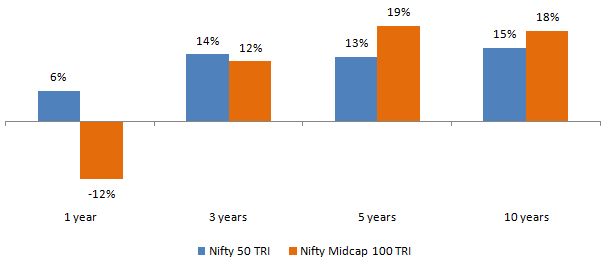
Source: Advisorkhoj Research
The above chart reinforces what we stated earlier, large cap provides more stability across market cycles but midcaps can give superior returns in the long term. I have seen that most online mutual fund content focuses on returns and not on risks, unless specific risk events affect investment returns. Most investors, as mentioned earlier, also base their investment decisions on past returns. In this blog post, we have discussed the risks of the midcap segment versus the large cap segment in relation to economic cycles). We will now discuss the quantitative impact of these risks on the large cap and midcap segments usingan analytical measure known as Drawdown.
What is Drawdown?
A drawdown is the peak-to-trough (high to low) decline during a specific recorded period of an investment, stock or mutual fund. A drawdown is usually quoted as the percentage between the peak and the subsequent trough.In order to understand risk of an investment, we measure drawdown during the worst market phases for the investment.
Why is drawdown important for investors? It gives investors a sense of what to expect in the worst case scenarios. Investors should understand that if the price of an asset falls from 100 to 75, it is a 25% fall, but for the asset to go back to 100 (from 75) will require a rise of 33%. In an extreme scenario if price falls from 100 to 50, even though it is a 50% fall, it will require a 100% rise to go back to 100. In a bear market, severe price damage can occur in fairly short period of time, especially when panic sets in. The eventual recovery however, can take much longer. For the large cap to midcap comparison, we will look at the worst phases over the last 10 years over whichthere were four bad phases for the broader market.
Jan 1, 2008 to Jan 23, 2009 - Drawdown
This was the worst financial crisis in our times. The financial crisis of 2008 was probably a Black Swan event; a very rare event, but not outside the realms of possibility in the future. The chart below shows the movement of Nifty 50 TRI and Nifty Midcap 100 TRI. The drawdown on Nifty was 57%, but the drawdown on Nifty Midcap 100 was 65%. The correction in Midcap was also swifter compared to Nifty and was stressful for investors.
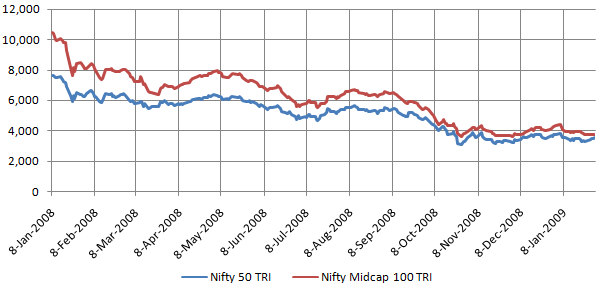
Source: National Stock Exchange
Jan 3, 2011 to Jan 12, 2012 - Drawdown
This correction came just 2 years after the bear market of 2008 and though the correction was not as severe as the 2008 financial crisis, Nifty fell by more than 20% during this period. The drawdown on Nifty was 25%, but the drawdown on Nifty Midcap 100 was 31%. The drawdown is more severe for Midcap. You can see a pattern emerging in bear markets. Let us see if the pattern held in the next bear market.
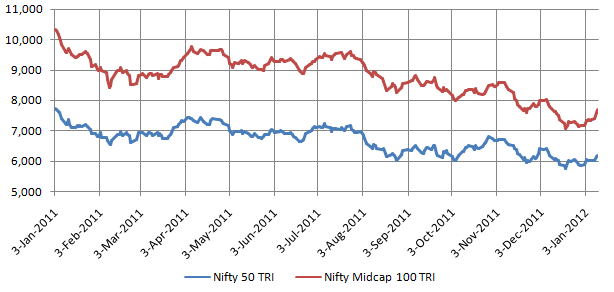
Source: National Stock Exchange
April 15, 2015 to March 31, 2016 - Drawdown
The pattern of large cap outperforming midcaps in a bear market did not hold during this period. The drawdown on the Nifty during this period was 20%, while that on Nifty Midcap 100 was 15%. The reason for this anomaly was that the bear market of 2015 was caused by global factors like fears of economic slowdown in China, Brexit fears and impending US Fed interest rate hike. Global factors affect large cap stocks more than midcap stocks since Foreign Institutional Investors (FIIs) account for a large portion of trading volumes of large cap stocks whereas in the midcap segment, FIIs do not play a significant role.
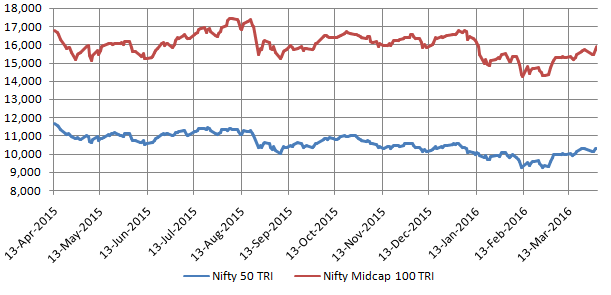
Source: National Stock Exchange
Jan 29, 2018 to October 21, 2018 - Drawdown
Though this year in totality has not been that bad for Nifty, it has been quite bad for the Midcap. The drawdown on the Nifty during this period was 15%, but the drawdown on Nifty Midcap 100 was 24%. On an YTD basis Nifty has recovered but Nifty Midcap 100 is still way off from its January highs. The old pattern of midcaps suffering more in bear markets seen in 2008 and 2011 re-emerged this year.
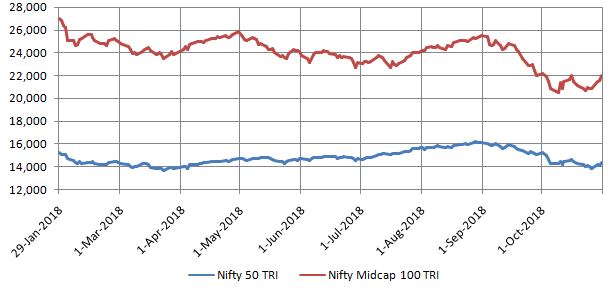
Source: National Stock Exchange
Why is portfolio stability important?
You saw in deep corrections midcaps generally saw more drawdown compared to large caps. Greater the price correction, longer is the likely recovery period. Therefore, if you are investing in midcap mutual funds you should have a much longer investment tenor. Based on our observation of retail investor behavior over the last 15 to 20 years, we can say that while many investors have the temperament of not being affected by moderate volatility, severe volatility (price correction of 20% or more) is stressful for many investors. Once panic sets in, investors make wrong investment decisions, which harm their financial interest in the long term.
Large caps on the other hand, have much higher price stability and therefore, less affected in volatile markets. As such, it is more suitable for investors who do not have very high risk appetites and inexperienced investors. If your portfolio is less volatile then you will be under less stress and less prone to making wrong investment decisions. Having a substantially big portion of your portfolio invested in large cap funds will help you remain disciplined in your investments and this will benefit you in the long term.
One consideration in portfolio construction should be to factor in the need for liquidity at any time. Your financial plan should ensure enough liquid assets to meet financial exigencies. However, if for any unforeseen cause, you have no other option but to meet a sudden liquidity requirement through redemptions from your equity funds, then large cap funds are better candidates for redemptions compared to midcap funds, especially if your sudden liquidity need arises in a volatile market / bear market. Large cap funds are less volatile than midcap funds and therefore, the actual loss and also opportunity loss caused by redemptions in bear markets is less in large cap funds. Liquidity considerations may suggest that large cap mutual funds should comprise a substantial part of your investment portfolio.
Suggested read: how to get the best out of mutual funds by avoiding common mistakes
Conclusion
Large cap mutual funds offer greater stability to your investment portfolio. In the long term, large cap funds can generate good returns and help you meet your financial goals. We are by no means suggesting that you ignore midcap or small cap funds. You can enhance your overall portfolio returns by having a portion of your assets in midcap or small cap mutual funds, but for reasons discussed in this blog post, large cap mutual funds or large cap oriented mutual funds should form the core of your equity investment portfolio.
You may also like to read: Diversification and how to take advantage of it
Mutual Fund Investments are subject to market risk, read all scheme related documents carefully.
RECOMMENDED READS
The information being provided under this section 'Investor Education' is for the sole purpose of creating awareness about Mutual Funds and for their understanding, in general. The views being expressed only constitute opinions and therefore cannot be considered as guidelines, recommendations or as a professional guide for the readers. Before making any investments, the readers are advised to seek independent professional advice, verify the contents in order to arrive at an informed investment decision.
Mutual Fund investments are subject to market risks, read all scheme related documents carefully.
Quick Links
Follow Nippon India MF
More About Nippon India MF
POST A QUERY






